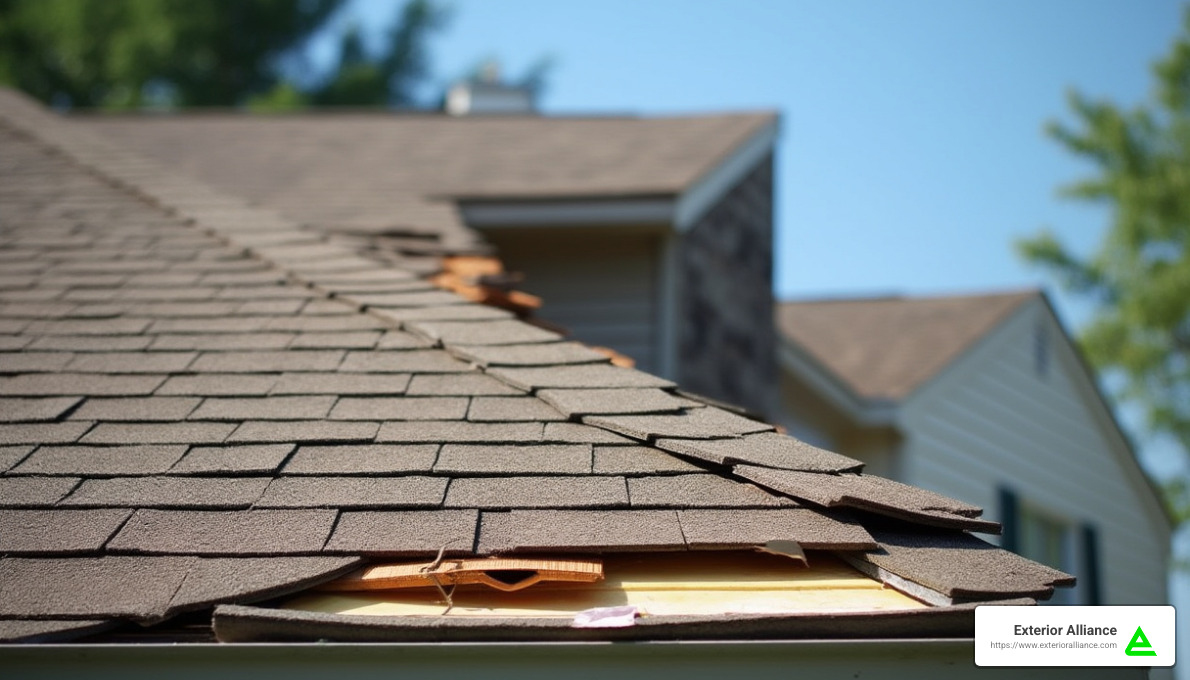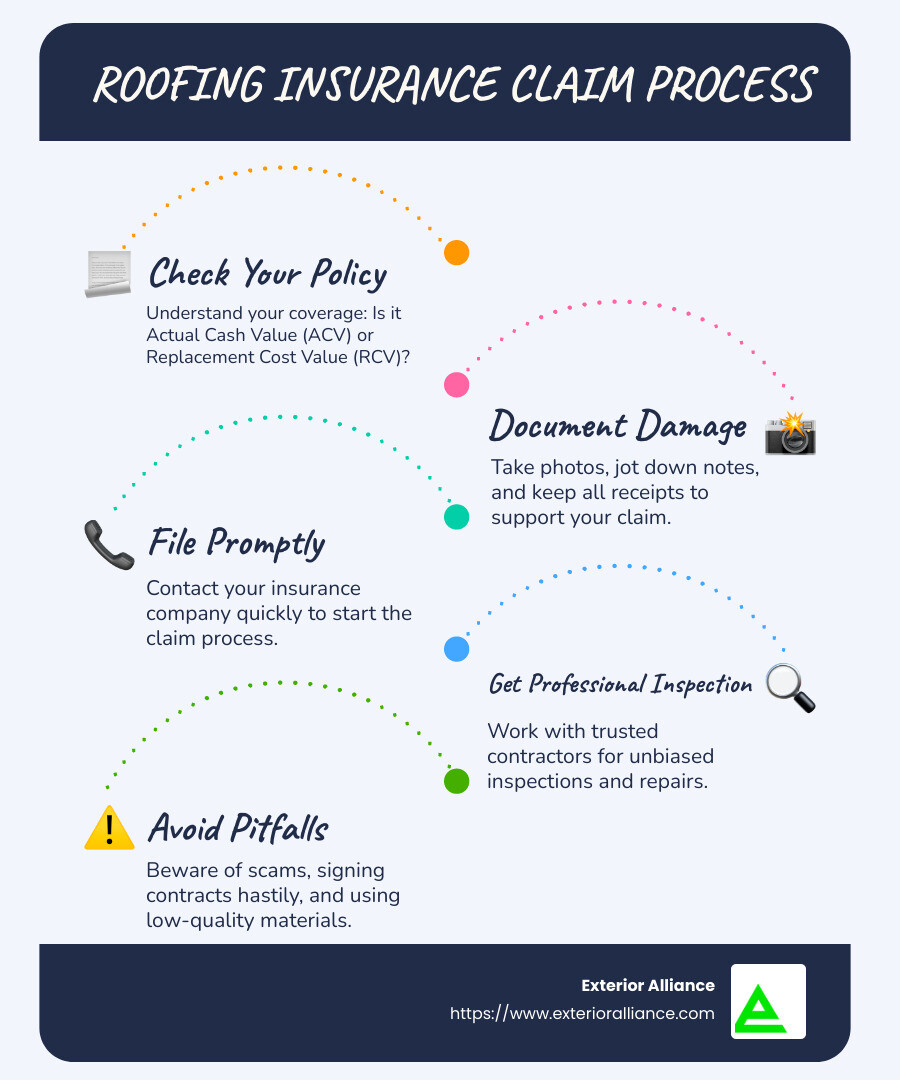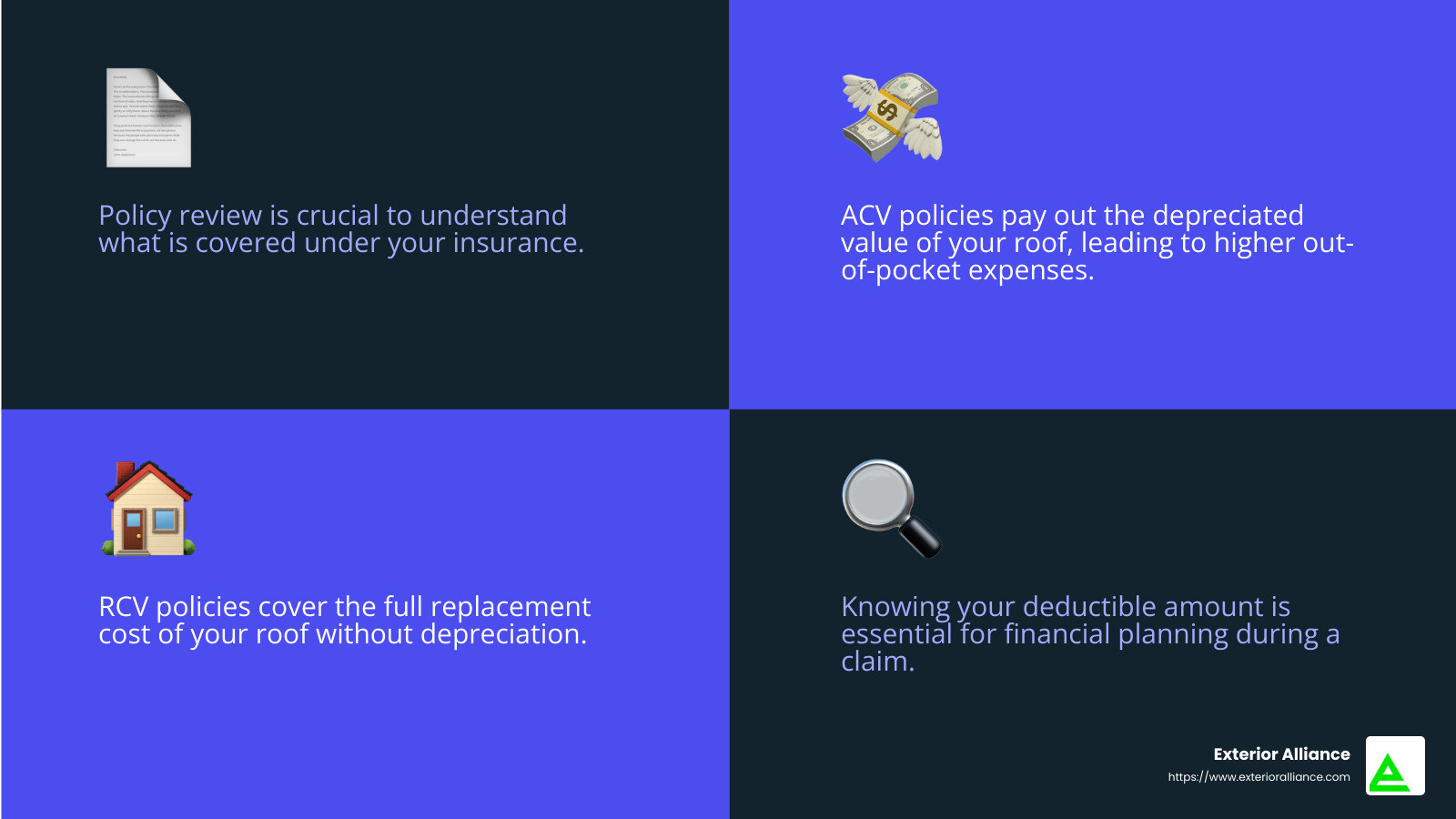
When a storm blows through Columbus, OH, your roof might just be the last line of defense standing strong—or not. Roofing insurance claim process can be daunting for the busy homeowner who finds themselves staring up at a roof that didn’t quite weather the weather. Are you stressed about potential damage and confused about how to steer your homeowners insurance?
Here’s a quick look at key pointers for addressing roof damage with your insurance:
- Check your policy: First, understand your coverage. Is it Actual Cash Value (ACV) or Replacement Cost Value (RCV)?
- Document everything: Take photos, jot notes, and keep those receipts.
- File promptly: Call your insurance and get the ball rolling before those drips become waterfalls.
- Work with professionals: Trusted contractors can guide you through inspections and repairs.
The journey from finding roof damage to seeing repairs completed can be perplexing. But understanding the basics of your homeowners insurance policy and knowing the steps in the claim process can ease a lot of that anxiety. Don’t let the stress cloud your judgement—arm yourself with information and a trustworthy roofing partner.

Understanding Your Insurance Policy
Navigating the roofing insurance claim process starts with understanding your insurance policy. It’s your roadmap to knowing what’s covered and what’s not. Here’s how to break it down:
Policy Review
Before you even file a claim, pull out your insurance policy and give it a thorough read. Know the specifics of your coverage, like what events are covered and any exclusions that might apply. This step is crucial for setting realistic expectations.
Coverage Types
Insurance policies generally fall into two categories: Actual Cash Value (ACV) and Replacement Cost Value (RCV).
- ACV Policy: This type of policy pays out the depreciated value of your roof. That means if your roof is ten years old, the payout reflects its age and wear. It often results in higher out-of-pocket expenses for you.
- RCV Policy: This policy covers the full cost of replacing your roof without considering depreciation. You’ll first receive a check for the roof’s current value, and after the work is completed, you’ll get another check covering the rest of the cost.

Deductible Amounts
Your deductible is the amount you pay before your insurance kicks in. Be aware that different types of damage might have different deductibles. For instance, wind and hail damage might have a separate deductible from other types of damage. Check this detail in your policy to avoid surprises.
ACV vs. RCV: A Quick Comparison
| Feature | ACV | RCV |
|---|---|---|
| Payout Basis | Depreciated Value | Full Replacement Cost |
| Out-of-Pocket Costs | Higher | Lower |
| Payment Timing | One-time Payment | Two Payments (Initial + Final) |
Understanding these key components of your insurance policy will prepare you for the next steps in the roofing insurance claim process. With this knowledge, you’ll be better equipped to handle claims, communicate with your insurer, and ultimately protect your home from further damage.
Next, we’ll walk you through the steps involved in filing a claim and getting it approved. Stay informed and prepared!
Steps in the Roofing Insurance Claim Process
Navigating the roofing insurance claim process can feel like a daunting task. But don’t worry, breaking it down into clear steps can make it much more manageable. Here’s how you can tackle each stage effectively:
Documenting Damage
The first step is to document the damage thoroughly. Use your phone or camera to take clear photos and videos of all affected areas. This includes shingles, gutters, and any other parts of your roof that show signs of damage.
Pro Tip: Note the date and cause of the damage, if possible, like a recent storm. This information can be crucial when you file your claim.
Professional Inspection
Next, hire a qualified roofing contractor for a professional inspection. This step is vital because a contractor can spot issues you might miss and provide an unbiased assessment.
A reliable contractor will document the damage with photos and detailed notes. They might even use specialized software to track recent weather events that could have caused the damage. This documentation will be invaluable when discussing your claim with your insurance provider.
Filing the Claim
Once you have all the necessary documentation, it’s time to file your claim. Contact your insurance company and provide them with all the evidence you’ve gathered.
- Include: Photos, videos, inspection reports, and any receipts for temporary repairs.
- Be Ready: Have your policy number and a summary of the damage handy. This speeds up the process.
Most insurance companies allow you to file claims online or over the phone. Choose the method that works best for you.
Adjuster Approval
After you file your claim, your insurance company will send an adjuster to assess the damage.
It’s important to be present during the adjuster’s visit. This way, you can point out all the damage and provide any additional information they might need. Having your contractor present can also be beneficial, as they can discuss any technical aspects directly with the adjuster.
Once the adjuster completes their inspection and approves the claim, you’ll receive the initial payment. This usually covers the actual cash value of your roof. After the repairs are completed, you’ll receive the final payment to cover the remaining costs.
By following these steps, you can ensure a smoother and more successful roofing insurance claim process. Stay organized, communicate effectively, and keep detailed records at every stage.
In the next section, we’ll explore common pitfalls in the claim process and how to avoid them.
Common Pitfalls and How to Avoid Them
When dealing with the roofing insurance claim process, it’s easy to make mistakes that can delay or even derail your claim. Let’s look at some common pitfalls and how you can steer clear of them:
Scams
Storm Chasers Alert! After a major storm, you might find roofers knocking on your door offering to fix your roof. These so-called “storm chasers” often use high-pressure tactics and promise quick fixes. However, they may not be in good standing with insurance companies and could leave you with subpar work.
Avoidance Tip: Always research and hire a local, trusted roofer with good reviews. Check their credentials and past work before signing any agreements.
Signing Contracts Without Understanding Terms
Signing a contract without fully understanding its terms can lead to unexpected costs or obligations. Some contracts might even include clauses that limit your options or lock you into using specific materials or contractors.
Avoidance Tip: Read every contract carefully. If you’re unsure about any terms, ask questions or consult a legal professional. Make sure everything is in writing and don’t rely on verbal promises.
Deductible Fraud
Beware of roofing companies that offer to “cover” your insurance deductible. This might sound like a great deal, but it’s actually illegal and constitutes insurance fraud. Engaging in this practice can result in serious legal consequences for both you and the contractor.
Avoidance Tip: Always pay your deductible. If a contractor suggests otherwise, it’s a red flag. Reputable companies won’t ask you to commit fraud.
Low-Quality Materials
Some contractors might try to cut corners by using low-quality materials. This can lead to poor performance and additional repairs down the line, reducing the lifespan of your new roof.
Avoidance Tip: Insist on high-quality materials and ensure your contract specifies the materials to be used. It’s also wise to research the materials yourself and understand their benefits and limitations.
By being aware of these pitfalls, you can steer the roofing insurance claim process more effectively and protect your home from further issues. In the next section, we’ll discuss how to work effectively with a roofing contractor to ensure a smooth claim process.
Working with a Roofing Contractor
Navigating the roofing insurance claim process can be complex, and having the right roofing contractor by your side can make all the difference. Here’s how to ensure you’re working with a contractor who will help, not hinder, your claim.
Experience with Claims
A contractor with experience in handling insurance claims is invaluable. They understand the paperwork, timelines, and nuances of dealing with insurance adjusters. This can vastly improve the chances of your claim being approved and processed smoothly.
Why it Matters: Experienced contractors can guide you through each step, from documenting damage to negotiating with your insurance company. They can even help ensure that all necessary repairs are covered under your claim, potentially saving you money.
Unbiased Inspection
Before filing a claim, it’s wise to have a professional inspection of your roof. An unbiased inspection can reveal hidden damage that you might miss. This thorough examination ensures that all issues are documented, which is crucial for a successful claim.
Tip: Choose a contractor who offers a free, no-obligation inspection. This way, you can get an honest assessment of the damage without any pressure to commit to their services.
Contractor Selection
Selecting the right contractor is a critical step in the roofing insurance claim process. Here are some tips to help you choose wisely:
- Check Credentials: Ensure the contractor is licensed and insured. This protects you from liability and ensures they meet industry standards.
- Read Reviews: Past customer experiences can provide insight into a contractor’s reliability and quality of work. Look for consistent positive feedback and a track record of satisfied customers.
- Ask for References: A reputable contractor will have no problem providing references from previous clients. Contact these references to ask about their experience.
- Compare Quotes: Obtain multiple quotes to ensure you receive fair pricing. However, be cautious of extremely low bids, which might indicate subpar work or hidden costs.
Remember: A local contractor with deep roots in your community is often the best choice. They are more likely to be familiar with local building codes and weather challenges, ensuring your roof is built to last.
By partnering with the right contractor, you can streamline the roofing insurance claim process and ensure your home is restored to its best condition. Next, we’ll dive into some frequently asked questions about the claim process to further clarify any lingering doubts.
Frequently Asked Questions about the Roofing Insurance Claim Process
What not to say to a roof insurance adjuster?
When speaking with a roof insurance adjuster, avoid admitting any fault or liability. Saying things like “I should have fixed that earlier” or “It’s partly my fault” can complicate your claim. Adjusters are trained to note anything that might reduce the insurance company’s liability. Stick to the facts and let the documentation speak for itself.
How long does it take for insurance to approve a roof claim?
The time it takes to get a roof claim approved can vary. On average, it might take anywhere from a few weeks to a couple of months. This depends on several factors, including the complexity of the damage and the insurance company’s procedures. State regulations can also affect timelines, as some states have specific rules on how quickly claims must be processed.
Tip: Stay in touch with your insurance provider and respond promptly to any requests for additional information. This can help speed up the process.
How to get approval of a roof claim?
To increase the chances of your claim being approved, follow these steps:
- Documenting Damage: Take clear, detailed photos of all damage. Include multiple angles and close-ups. Date-stamped photos are especially helpful.
- Professional Inspection: Hire a professional to inspect the roof. An unbiased inspection can uncover hidden issues that might be missed otherwise. This ensures all damage is documented accurately.
- Submit a Complete Claim: Provide all necessary documentation, including inspection reports and photos, when filing your claim. This thoroughness demonstrates the legitimacy of your claim.
Remember: A well-documented claim is more likely to be approved swiftly. Keep records of all communications with your insurance company and be proactive in following up on your claim status.
These FAQs should help explain some of the common concerns about the roofing insurance claim process. In the next section, we will explore more about how Exterior Alliance can assist you further.
Conclusion
At Exterior Alliance, we understand that navigating the roofing insurance claim process can be daunting. Our commitment to quality and excellence sets us apart as a trusted partner for homeowners in Dublin, Ohio, and beyond. With our local expertise, we aim to simplify this process, ensuring you get the best possible outcome with minimal stress.
Why Choose Exterior Alliance?
- Local Expertise: Being a locally-owned company, we have a deep understanding of the specific weather challenges and roofing needs in Ohio. This local knowledge allows us to provide custom solutions that meet the unique demands of your home and community.
- Commitment to Quality: We are committed to delivering top-notch roofing services. Our team is trained, insured, and dedicated to maintaining the highest standards. Plus, our A+ rating with the Better Business Bureau speaks volumes about our dedication to customer satisfaction.
- Seamless Claim Assistance: We assist you at every step of your insurance claim. From the initial inspection to the final repairs, our experienced team ensures that your roof is restored efficiently and effectively. We work closely with your insurance company to make the process as smooth as possible.
As you consider your options for roof repair or replacement, working with a reputable contractor is crucial. At Exterior Alliance, we pride ourselves on our transparency, reliability, and commitment to helping you protect your most valuable asset—your home.
If you want to learn more about how we can assist you with your roofing needs, including understanding RCV vs. ACV vs. RPS, please visit our service page.
Thank you for considering Exterior Alliance. We look forward to serving you and ensuring your home remains safe and secure.

